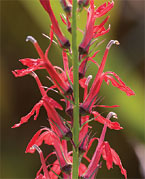
Weed Management
In a similar manner that insects and diseases play a "canary in the coal mine" role, the types of weeds that exist in a lawn may indicate a specific underlying problem. Often identifying the problem will help suppress weeds. For example, crab grass can proliferate on compacted, acidic (low pH) soils. Often aerating the area, and applying compost and limestone, as well as physically removing the crabgrass will help stimulat the desired turfgrass which crowds out the crabgrass.
In addition, overseeding the lawn with a perennial turfgrass mixture in the early spring and fall will help to crowd out weeds. Seeding bare spots and thin areas as well as applying a 1/4 inch of compost at seeding will help prevent the germination of weed seeds. Raising the lawn mower blade to keep grass at 3 or 4 inches will shade the soil surface and prevent weed seeds from germinating. Lastly, hand pulling, before weeds set seed and get out of control will help deter future weed growth as long as the underlying soil problem or cultural practice causing the weeds is identified.
In an organic program, it is important to define a tolerance level of weeds. An organic lawn will never be completely weed free; but a well balanced lawn with high quality soils will promote healthy turf that can outcompete most weeds.
Native Plants

Cardinal Flower
Utilizing native plants can help achieve an important goal of organic land care: limited use of offsite inputs necessary for a healthy, sustainable landscape. Plants that are native to a region are those that were present before European colonization and have adapted to the local environmental conditions. Native plants support local food webs including a wide variety of birds, butterflies, and other insects and often these species are dependent on certain native plants for survival.
New Jersey has over 2,000 native plants. We are lucky to live in an ecoregion with a diversity of native flowering plant species that, when properly selected, can provide color, habitat, and interest throughout the year. Whether you have a large yard or a few pots on a deck, there are opportunities to celebrate our native species that support pollinators and other wildlife.
Incorporating native plants into a home landscape can help increase diversity and habitat, as well as reduce the need for watering and fertilizer applications. Native plants can be used to create a natural-looking landscape, or they can easily be incorporated into a more formal or ornamental garden. Native plants are becoming more commonly available at home centers and nurseries but often still require work to find local sources of native plants.
For more information about native plants visit these resources:
Frequently Asked Questions About Native Plants
New Jersey Native Plant Society
Jersey Friendly Yards Plants Database
National Wildlife Federation Keystone Plants by Ecoregion
Supporting Bees in Your Garden and on Your Farm

